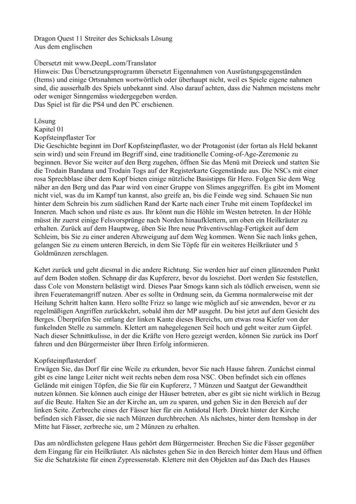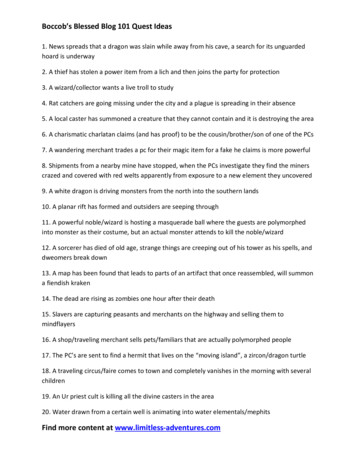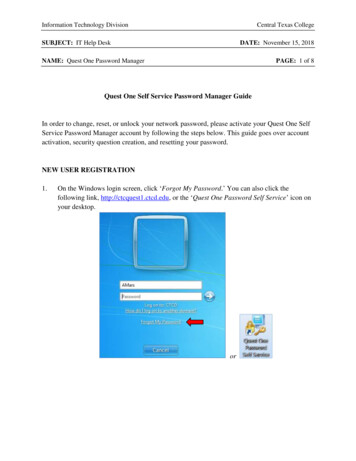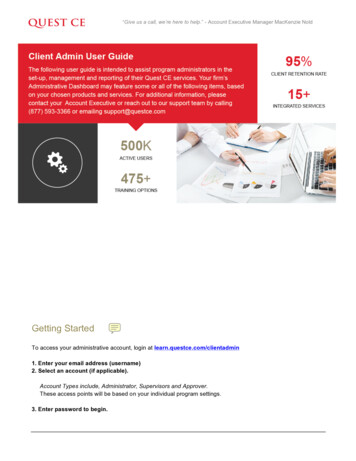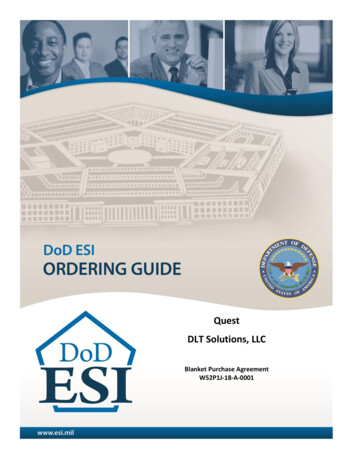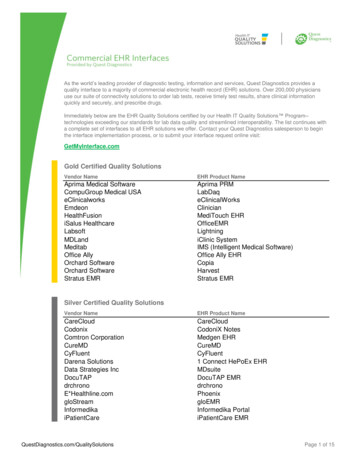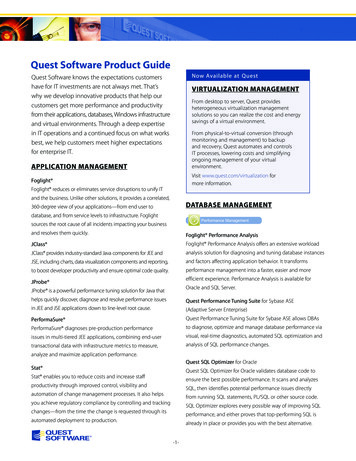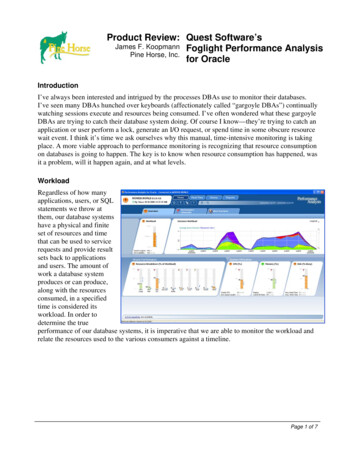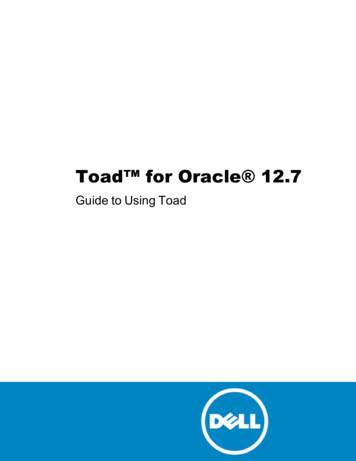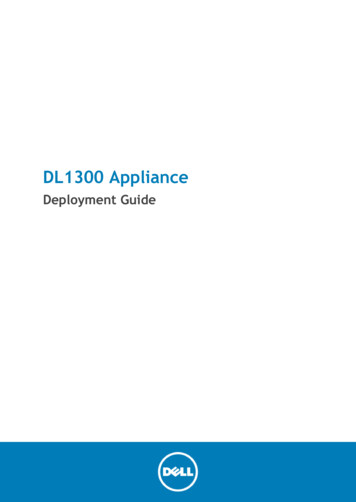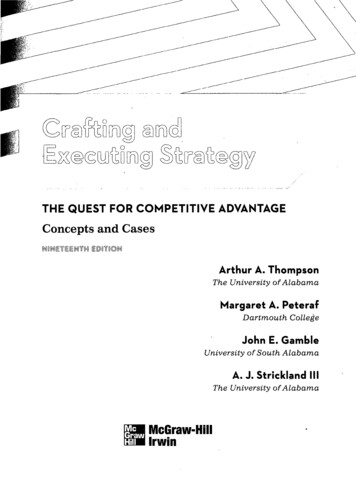
Transcription
oOO 7(g THE QUEST FOR COMPETITIVE ADVANTAGEConcepts and CasesITlArthur A. ThompsonThe University of AlabamaMargaret A. PeterafDartmouth CollegeJohn E. GambleUniversity of South AlabamaA. J. Strickland IIIThe University of AlabamaMcGraw-HillIrwin
I**PART ONE Concepts and Techniques for Crafting andExecuting Strategy 1Section A: Introduction and Overview1 WHAT IS STRATEGY AND WHY IS IT IMPORTANT? 2WHAT DO WE MEAN BY STRATEGY? 4Strategy and the Quest for Competitive AdvantageWhy a Company's Strategy Evolves over Time 85A Company's Strategy Is Partly Proactive and Partly Reactive8A COMPANY'S STRATEGY AND ITS BUSINESS MODEL 10WHAT MAKES A STRATEGY A WINNER? 12WHY CRAFTING AND EXECUTING STRATEGY ARE IMPORTANT TASKS 12Good Strategy Good Strategy Execution Good Management 13THE ROAD AHEAD 13ILLUSTRATION CAPSULE1.1 McDonald's Strategy in the Quick-Service Restaurant Industry 61.2 Sirius XM and Over-the-Air Broadcast Radio: Two Contrasting BusinessModels 112 CHARTING A COMPANY'S DIRECTION: ITS VISION, MISSION,OBJECTIVES, AND'STRATEGY 18WHAT DOES THE STRATEGY-MAKING, STRATEGY-EXECUTING PROCESSENTAIL? 19TASK 1: DEVELOPING A STRATEGIC VISION, A MISSION STATEMENT, AND'A SET OF CORE VALUES 2 0Developing a Strategic Vision 21Communicating the Strategic Vision 21Developing a Company Mission Statement 24Linking the Vision and Mission with Company Values 25TASK 2: SETTING OBJECTIVES 27TASK 3: CRAFTING A STRATEGY 31Strategy Making Involves Managers at All Organizational Levels 31A Company's Strategy-Making Hierarchy 32Uniting the Strategy-Making Hierarchy 34A Strategic Vision Objectives Strategy A Strategic Plan 35TASK 4 : EXECUTING THE STRATEGY 35TASK 5: EVALUATING PERFORMANCE AND INITIATING CORRECTIVEADJUSTMENTS 36CORPORATE GOVERNANCE: THE ROLE OF THE BOARD OF DIRECTORSIN THE STRATEGY-CRAFTING, STRATEGY-EXECUTING PROCESS 37
ContentsILLUSTRATION CAPSULE2.1 Examples of Strategic Visions—How Well Do They Measure Up?2.2 Zappos Family Mission and Core Values2.3 Examples of Company Objectives2326302.4 Corporate Governance Failures at Fannie Mae and Freddie Mac 39Section B: Core Concepts and Analytical Tools3 EVALUATING A COMPANY'S EXTERNAL ENVIRONMENT 44QUESTION 1: WHAT ARE THE STRATEGICALLY RELEVANT FACTORS INTHE MACRO-ENVIRONMENT? 4 6ASSESSING THE COMPANY'S INDUSTRY AND COMPETITIVEENVIRONMENT 4 8QUESTION 2: HOW STRONG ARE THE INDUSTRY'S COMPETITIVEFORCES? 49Competitive Pressures Created by the Rivalry among Competing Sellers 49Competitive Pressures Associated with the Threat of New Entrants 54Competitive Pressures from the Sellers of Substitute Products 56Competitive Pressures Stemming from Supplier Bargaining Power 58Competitive Pressures Stemming from Buyer Bargaining Power and PriceSensitivity 60Is the Collective Strength of the Five Competitive Forces Conducive to GoodProfitability? 63QUESTION 3: WHAT FACTORS ARE DRIVING INDUSTRY CHANGE, ANDWHAT IMPACT WILL THEY HAVE? 6 4The Concept of Industry Driving Forces 64Identifying an Industry's Driving Forces 64Assessing the Impact of the Factors Driving Industry Change 68Adjusting Strategy to Prepare for the Impacts of Driving Forces 68QUESTION 4 : HOW ARE INDUSTRY RIVALS POSITIONED IN THEMARKET? 68Using Strategic Group Maps to Assess the Market Positions of KeyCompetitors 69The Value of Strategic Group Maps? 70QUESTION 5: WHAT STRATEGIC MOVES ARE RIVALS LIKELY TO MAKENEXT? 71A FRAMEWORK FOR COMPETITOR ANALYSIS 71QUESTION 6: WHAT ARE THE INDUSTRY'S KEY FACTORS? 73QUESTION 7: IS THE INDUSTRY OUTLOOK CONDUCIVE TO GOODPROFITABILITY? 75ILLUSTRATION CAPSULE3.1 Comparative Market Positions of Producers in the U.S. Beer Industry:A Strategic Group Map Example 703.2 Business Ethics and Competitive Intelligence73
Contents4 EVALUATING A COMPANY'S RESOURCES, CAPABILITIES, ANDCOMPETITIVENESS 80QUESTION 1: HOW WELL IS THE COMPANY'S PRESENT STRATEGYWORKING? 81QUESTION 2: WHAT ARE THE COMPANY'S COMPETITIVELY IMPORTANTRESOURCES AND CAPABILITIES? 86Identifying the Company's Resources and Capabilities 86Assessing the Competitive Power of a Company's Resources andCapabilities 89QUESTION 3: IS THE COMPANY ABLE TO SEIZE MARKET OPPORTUNITIESAND NULLIFY EXTERNAL THREATS? 92Identifying a Company's Internal Strengths 92Identifying Company Weaknesses and Competitive Deficiencies 93Identifying a Company's Market Opportunities 94Identifying the Threats to a Company's Future Profitability 94What Do the SWOT Listings Reveal? 96QUESTION 4: ARE THE COMPANY'S COST STRUCTURE AND CUSTOMERVALUE PROPOSITION COMPETITIVE? 97The Concept of a Company Value Chain 98The Value Chain System 1O1Benchmarking: A Tool for Assessing Whether the Costs and Effectiveness of aCompany's Value Chain Activities Are in Line 103Strategic Options for Remedying a Cost or Value Disadvantage 104Improving Internally Performed Value Chain Activities 105Translating Proficient Performance of Value Chain Activities into CompetitiveAdvantage 1O6QUESTION 5: IS THE COMPANY COMPETITIVELY STRONGER OR WEAKERTHAN KEY RIVALS? 108Strategic Implications of Competitive Strength Assessments 109QUESTION 6: WHAT STRATEGIC ISSUES AND PROBLEMS MERIT FRONTBURNER MANAGERIAL ATTENTION? I l lILLUSTRATION CAPSULE4.1 The Value Chain for KP MacLane, a Producer of Polo Shirts 1004.2 Benchmarking and Ethical Conduct 104Section C: Crafting a Strategy5 THE FIVE GENERIC COMPETITIVE STRATEGIES 120THE FIVE GENERIC COMPETITIVE STRATEGIES 121LOW-COST PROVIDER STRATEGIES 122The Two Major Avenues for Achieving a Cost Advantage 123The Keys to Being a Successful Low-Cost Provider 128When a Low-Cost Provider Strategy Works Best 128Pitfalls to Avoid in Pursuing a Low-Cost Provider Strategy 129
xlContentsBROAD DIFFERENTIATION STRATEGIES 129Managing the Value Chain to Create the Differentiating Attributes 130Delivering Superior Value via a Broad Differentiation Strategy 132When a Differentiation Strategy Works Best 134Pitfalls to Avoid in Pursuing a Differentiation Strategy 134FOCUSED (OR MARKET NICHE) STRATEGIES 135 A Focused Low-Cost Strategy 136A Focused Differentiation Strategy 136When a Focused Low-Cost or Focused Differentiation Strategy IsAttractive 139The Risks of a Focused Low-Cost or Focused Differentiation Strategy 139BEST-COST PROVIDER STRATEGIES 140When a Best-Cost Provider Strategy Works Best 14OThe Big Risk of a Best-Cost Provider Strategy 141THE CONTRASTING FEATURES OF THE FIVE GENERIC COMPETITIVESTRATEGIES: A SUMMARY 142Successful Competitive Strategies Are Resource-Based 143ILLUSTRATION CAPSULE5.1 How Walmart Managed Its Value Chain to Achieve a Huge Low-CostAdvantage over Rival Supermarket Chains 1275.2 Aravind Eye Care System's Focused Low-Cost Strategy 1375.3 Popchips's Focused Differentiation Strategy 1385.4 Toyota's Best-Cost Provider Strategy for Its Lexus Line 1416 STRENGTHENING A COMPANY'S COMPETITIVEPOSITION 148GOING ON THE OFFENSIVE-STRATEGIC OPTIONS TO IMPROVE ACOMPANY'S MARKET POSITION 150Choosing the Basis for Competitive Attack 150Choosing Which Rivals to Attack 152Blue-Ocean Strategy—A Special Kind of Offensive 152DEFENSIVE STRATEGIES-PROTECTING MARKET POSITION ANDCOMPETITIVE ADVANTAGE 154Blocking the Avenues Open to Challengers 154Signaling Challengers that Retaliation Is Likely 155TIMING A COMPANY'S OFFENSIVE AND DEFENSIVE STRATEGICMOVES 155The Potential for First-Mover Advantages 155The Potential for Late-Mover Advantages or First-Mover Disadvantages 156To Be a First Mover or Not 157STRENGTHENING A COMPANY'S MARKET POSITION VIA ITS SCOPE OFOPERATIONS 158HORIZONTAL MERGER AND ACQUISITION STRATEGIES 159Why Mergers and Acquisitions Sometimes Fail to Produce AnticipatedResults 161
ContentsVERTICAL INTEGRATION STRATEGIES 162The Advantages of a Vertical Integration Strategy 162The Disadvantages of a Vertical Integration Strategy 164Weighing the Pros and Cons of Vertical Integration 165OUTSOURCING STRATEGIES: NARROWING THE SCOPE OFOPERATIONS 166The Big Risk of Outsourcing Value Chain Activities 167STRATEGIC ALLIANCES AND PARTNERSHIPS 168Why and How Strategic Alliances Are Advantageous 170Capturing the Benefits of Strategic Alliances 171The Drawbacks of Strategic Alliances and Partnerships 172How to Make Strategic Alliances Work 173ILLUSTRATION CAPSULE6.1 Gilt Groupe's Blue-Ocean Strategy in the U.S. Flash Sale Industry 1536.2 Amazon.corn's First-Mover Advantage in Online Retailing 1576.3 Bristol-Myers Squibb's "String-of-Pearls" Horizontal AcquisitionStrategy 1616.4 American Apparel's Vertical Integration Strategy 1667 STRATEGIES FOR COMPETING IN INTERNATIONALMARKETS 178WHY COMPANIES DECIDE TO ENTER FOREIGN MARKETS 179WHY COMPETING ACROSS NATIONAL BORDERS MAKES STRATEGYMAKING MORE COMPLEX 180Porter's Diamond of National Competitive Advantage 181Locating Value Chain Activities Advantageously 183The Impact of Government Policies and Economic Conditions in HostCountries 184The Risks of Adverse Exchange Rate Shifts 185Cross-Country Differences in Demographic, Cultural, and Market Conditions 187STRATEGIC OPTIONS FOR ENTERING AND COMPETING ININTERNATIONAL MARKETS 188Export Strategies 188Licensing Strategies 189Franchising Strategies 189Foreign Subsidiary Strategies 189Alliance and Joint Venture Strategies 190COMPETING INTERNATIONALLY: THE THREE MAIN STRATEGICAPPROACHES 193Multidomestic Strategy—Think Local, Act Local 193Global Strategy-Think Global, Act Global 195Transnational Strategy—Think Global, Act Local 196THE QUEST FOR COMPETITIVE ADVANTAGE IN THE INTERNATIONALARENA 198Using Location to Build Competitive Advantage 198xli
xliiContentsSharing and Transferring Resources and Capabilities across Borders to BuildCompetitive Advantage 199Benefiting from Cross-Border Coordination 201PROFIT SANCTUARIES AND CROSS-BORDER STRATEGIC MOVES 201Using Profit Sanctuaries to Wage a Strategic Offensive 203Using Profit Sanctuaries to Defend against International Rivals 203STRATEGIES FOR COMPETING IN THE MARKETS OF DEVELOPINGCOUNTRIES 2 0 4Strategy Options for Competing in Developing-Country Markets 204DEFENDING AGAINST GLOBAL GIANTS: STRATEGIES FOR LOCALCOMPANIES IN DEVELOPING COUNTRIES 207ILLUSTRATION CAPSULE7.1 Solazyme's Cross-Border Alliances with Unilever, Sephora.Qantas, andRoquette 1927.2 Yum! Brands's Strategy for Becoming the Leading Food Service Brand inChina 2057.3 How Ctrip Successfully Defended against International Rivals toBecome China's Largest Online Travel Agency 2088 CORPORATE STRATEGY 214WHAT DOES CRAFTING A DIVERSIFICATION STRATEGY ENTAIL? 215WHEN BUSINESS DIVERSIFICATION BECOMES A CONSIDERATION 216BUILDING SHAREHOLDER VALUE: THE ULTIMATE JUSTIFICATION FORDIVERSIFYING 217APPROACHES TO DIVERSIFYING THE BUSINESS LINEUP 218Diversification by Acquisition of an Existing Business 218Entering a New Line of Business through Internal Development 219Joint Ventures 219Choosing a Mode of Entry 220CHOOSING THE DIVERSIFICATION PATH: RELATED VERSUS UNRELATEDBUSINESSES 221DIVERSIFYING INTO RELATED BUSINESSES 221Identifying Cross-Business Strategic Fit along the Value Chain 224Strategic Fit, Economies of Scope, and Competitive Advantage 226DIVERSIFICATION INTO UNRELATED BUSINESSES 228Building Shareholder Value via Unrelated Diversification 228The Path to Greater Shareholder Value through Unrelated Diversification 3 1The Drawbacks of Unrelated Diversification 231Misguided Reasons for Pursuing Unrelated Diversification 232COMBINATION RELATED-UNRELATED DIVERSIFICATION STRATEGIES 233EVALUATING THE STRATEGY OF A DIVERSIFIED COMPANY 233Step l: Evaluating Industry Attractiveness 234Step 2: Evaluating Business-Unit Competitive Strength 237Step 3: Determining the Competitive Value of Strategic Fit in DiversifiedCompanies 241Step 4: Checking for Resource Fit 242
ContentsStep 5: Ranking Business Units and Assigning a Priority for ResourceAllocation 244Step 6: Crafting New Strategic Moves to Improve Overall CorporatePerformance 245ILLUSTRATION CAPSULE8.1 Managing Diversification at Johnson & Johnson: The Benefits of CrossBusiness Strategic Fit 2488.2 Growth through Restructuring at Kraft Foods2509 ETHICS, CORPORATE SOCIAL RESPONSIBILITY,ENVIRONMENTAL SUSTAINABILITY, AND STRATEGY 256WHAT DO WE MEAN BY BUSINESS ETHICS? 257WHERE DO ETHICAL STANDARDS COME FROM-ARE THEY UNIVERSALOR DEPENDENT ON LOCAL NORMS? 258The School of Ethical Universalism 258The School of Ethical Relativism 258Ethics and Integrative Social Contracts Theory 262HOW AND WHY ETHICAL STANDARDS IMPACT THE TASKS OF CRAFTINGAND EXECUTING STRATEGY 262WHAT ARE THE DRIVERS OF UNETHICAL STRATEGIES AND BUSINESSBEHAVIOR? 263WHY SHOULD COMPANY STRATEGIES BE ETHICAL? 268The Moral Case for an Ethical Strategy 268The Business Case for Ethical Strategies 268STRATEGY, CORPORATE SOCIAL RESPONSIBILITY, AND ENVIRONMENTALSUSTAINABILITY 2 7 0What Do We Mean by Corporate Social Responsibility? 270What Do We Mean by Sustainability and Sustainable Business Practices? 275Crafting Corporate Social Responsibility and Sustainability Strategies 277The Moral Case for Corporate Social Responsibility and EnvironmentallySustainable Business Practices 278The Business Case for Corporate Social Responsibility and EnvironmentallySustainable Business Practices 279ILLUSTRATION CAPSULE9.1 Apple's Failures in Enforcing Its Supplier Code of Conduct2599.2 Investment Fraud at Bernard L. Madoff Investment Securities andStanford Financial Group 2659.3 How Novo Nordisk Puts Its Ethical Principles into Practice2679.4 Burt's Bees: A Strategy Based on Corporate Social ResponsibilitySection D: Executing the Strategy10 BUILDING AN ORGANIZATION CAPABLE OF GOODSTRATEGY EXECUTION286A FRAMEWORK FOR EXECUTING STRATEGY 288The Principal Components of the Strategy Execution Process 288273xliii
xlivContentsBUILDING AN ORGANIZATION CAPABLE OF GOOD STRATEGYEXECUTION: THREE KEY ACTIONS 290STAFFING THE ORGANIZATION 292Putting Together a Strong Management Team 292Recruiting, Training, and Retaining Capable Employees293ACQUIRING, DEVELOPING, AND STRENGTHENING KEY RESOURCES ANDCAPABILITIES 295Three Approaches to Building and Strengthening Capabilities 296The Stra
THE FIVE GENERIC COMPETITIVE STRATEGIES 121 LOW-COST PROVIDER STRATEGIES 122 The Two Major Avenues for Achieving a Cost Advantage 123 The Keys to Being a Successful Low-Cost Provider 128 When a Low-Cost Provider Strategy Works Best 128 Pitfalls to Avoid in Pursuing a Low-Cost Provider Strategy 129. xl Contents BROAD DIFFERENTIATION STRATEGIES 129
